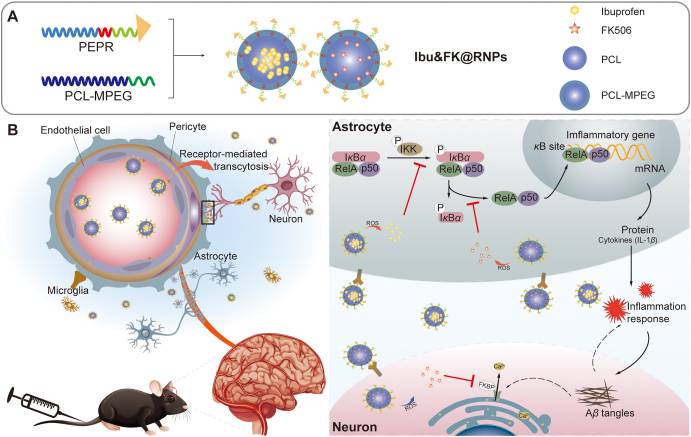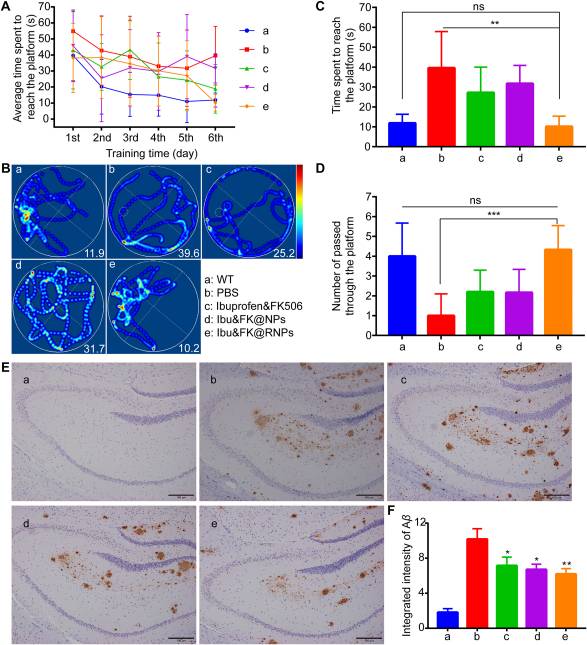Neuroinflammation, is characterized by excessively activated glial cells and overexpressed inflammatory factors in Alzheimer’s disease (AD).
Nonsteroidal anti-inflammatory drugs (NSAIDs) are most widely used drugs in inhibiting NF-κB signaling pathway, and high-dose of ibuprofen have been confirmed to improve dementia-like symptoms in AD animal models.
Therefore, anti-neuroinflammatory treatment might undermine the positive feedback loop of neuroinflammation and neuronal dysfunction.
But ibuprofen can't make neuronal damages reversed to cure AD completely. So it is necessary to use additional neuroprotective drugs . Calcineurin inhibitor (tacrolimus, FK506), is one of the most effective neuroprotective drug in central nervous system diseases. Moreover, the amelioration of AD-like behavior has been observed in patients taking FK506
 Xueqin He, Huile Gao from Sichuan and Macau universities, established an ibuprofen and FK506 encapsulated drug co-delivery system, which can target the receptor of advanced glycation endproducts and response to the high level of reactive oxygen species in Alzheimer's disease.
Xueqin He, Huile Gao from Sichuan and Macau universities, established an ibuprofen and FK506 encapsulated drug co-delivery system, which can target the receptor of advanced glycation endproducts and response to the high level of reactive oxygen species in Alzheimer's disease.
Methods used to get through the blood–brain barrier (BBB) may entail the use of endogenous transport systems, including carrier-mediated transporters (CMT), such as glucose and amino acid carriers, receptor-mediated transcytosis for insulin or transferrin, and the blocking of active efflux transporters such as p-glycoprotein.
Yet traditional CMT-based brain targeting delivery leads to unselective distribution in whole brain because of the homogenous expression of targeted receptors on BBB31. It is therefore important to find targets that are restrictively expressed on BBB of lesion. In AD lesion sites, the receptor of advanced glycation endproducts (RAGE) is specifically and highly expressed on the diseased neurovascular unit, including cerebral vascular endothelial cells, astrocytes and neurons.
As RAGE is highly and specifically expressed on the lesion neurovascular unit of Alzheimer's disease, this property helps to improve specificity of drug targeting the system and reduce unselective distribution in normal brain.
RAP peptide (sequence: CELKVLMEKEL) is a specific ligand of RAGE, which could assist with the transportation of nanoparticles into diseased brain parenchyma through CMT.
Thus, ibuprofen and FK506 delivery can be specifically released in astrocytes of Alzheimer's disease lesion in response to high levels of ROS.
As a result, the cognition of Alzheimer's disease mice was significantly improved and the quantity of A plaques was decreased. Neurotoxicity was also alleviated with structural regeneration and functional recovery of neurons. Besides, the neuroinflammation dominated by NF-B pathway was significantly inhibited with decreased NF-B and IL-1 in the brain.
 Overall, Ibu&FK@RNPs can efficiently and successively target diseased BBB and astrocytes in Alzheimer's disease lesion. Thus it significantly treats Alzheimer's disease by anti-neuroinflammation and neuroprotection.
Overall, Ibu&FK@RNPs can efficiently and successively target diseased BBB and astrocytes in Alzheimer's disease lesion. Thus it significantly treats Alzheimer's disease by anti-neuroinflammation and neuroprotection.
Read the original article on Pubmed


 In
In